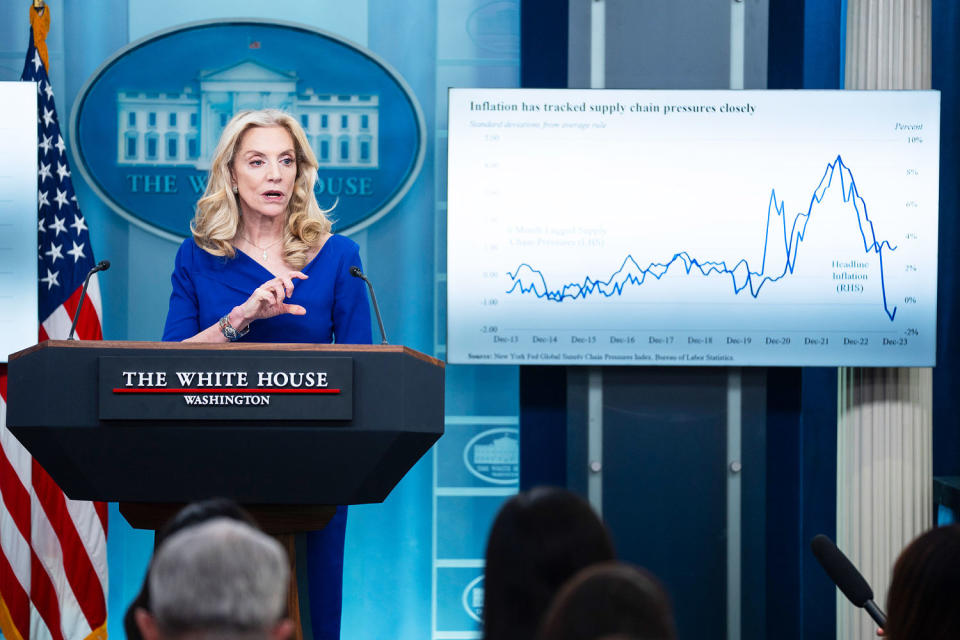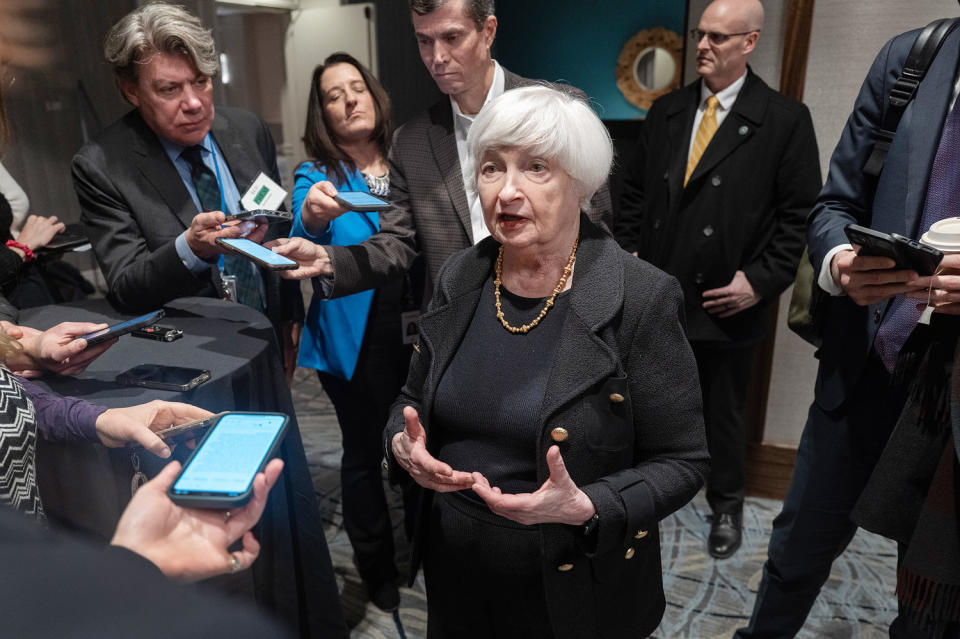After a year of recession doomsaying, an unexpectedly resilient economy is boosting the White House as it ramps up selling its record to Americans who’ve just started shaking off their “vibecession.”
At the same time, senior administration officials say they’re increasingly confident the situation on the ground can largely speak for itself. The economy grew at a strong 3.1% pace between the fourth quarter of 2022 and the same period last year, every inflation measure is cooling, the job market remains strong and the stock market has hit record highs.
“Extraordinary” is how Lael Brainard, director of the National Economic Council, described the economy to reporters at the White House on Friday.

“We looked historically — we’ve never had a year where inflation has declined this fast while the economy has grown above trend and unemployment has remained stable at a low rate,” she said.
Jared Bernstein, chair of the White House Council of Economic Advisers, said in an interview Friday that the economy is “a growth machine that keeps on delivering,” fueled by a tight labor market, robust consumer spending and rising real wages.
And in a speech Thursday at the Economic Club of Chicago, Treasury Secretary Janet Yellen boasted that the United States “now produces far more goods and services than it did before the pandemic,” on the heels of a recovery she called the most equitable on record.
The dual challenge now for President Joe Biden — and leaders in both his administration and re-election campaign — is to keep those trends humming while getting more Americans to notice them.
There’s some evidence they already are. The University of Michigan’s consumer sentiment index soared in December and January, posting the best two-month improvement since 1991. While views of the economy diverge along partisan lines, Democrats and Republicans alike registered their most favorable readings in more than two years.
Some business owners who spent last year battening down the hatches for a recession were pleasantly surprised that it never came.
Josh Burg, who owns a glass manufacturing company called Glass Enterprises in Bensalem, Pennsylvania, said the persistently strong economy caught him off guard. Having braced for a slowdown last year, he instead wound up hiring more workers, taking on new business and growing both his top and bottom lines. He gives the current economy a grade of A- and said he would hire even more people if he could find them.
“2023 was a good year. And I think most companies, if they’re engaged, would say the same thing,” he said.
But Burg hasn’t shrugged off skepticism completely. He’s still worried about high interest rates and cheap imports.
“When I evaluate the candidates, it’s who’s going to protect business, and for me — completely biased — who’s going to protect manufacturing.”
Former President Donald Trump, the overwhelming front-runner for the GOP nomination, has argued that Biden’s economic policies are failing. He said earlier this month in a right-wing media interview, “When there’s a crash, I hope it’s going to be during this next 12 months because I don’t want to be Herbert Hoover.”
A Biden campaign spokesperson called the latest economic data proof of “the Biden agenda at work,” predicting a second Trump administration would reverse gains for middle-class households. “We’re investing early and aggressively to ensure voters understand the choice this November,” he said.
For its part, the White House plans to keep chipping away at uncertainty like Burg’s by highlighting pocketbook wins — like lowering insulin costs for many diabetic patients and trimming out-of-pocket Medicare drug prices — and by pushing back against overdraft and other “junk” fees, with more cost-cutting efforts in the months ahead.
It’s policy on a smaller scale than the historic investments in climate, infrastructure and manufacturing — some of them bipartisan — that Democrats enacted before Republicans narrowly regained the House in the midterms. But it’s all part of the administration’s plan to show its economic program is succeeding.


While senior White House officials say they feel more self-assured in making that case, they’re still wary of sounding tone-deaf.
“The president and I understand that many Americans have long felt a deeper pessimism about the economy going back far before the pandemic,” Yellen said Thursday, adding that “life is still harder than it should be for the middle class in this country.”
By around Thanksgiving, the term “Bidenomics” had all but vanished from Biden’s public remarks, after an earlier push to embrace it. At the time, some Democratic strategists and allies of the president argued the label wasn’t resonating with Americans’ unusually sour economic outlook, and Republicans were using it to blame Biden for high inflation.
The White House insists “Bidenomics” hasn’t been retired as a buzzword. Biden and Yellen both used the term at least once in their public appearances this week. But administration officials emphasize that they’re more focused on keeping the trend lines moving upward and say the public mood will follow — reducing the need for a branding exercise.
“Our work is not done,” Bernstein said, acknowledging that there are still “banana peels everywhere” to circumvent, from geopolitical risks to a potential government shutdown. Still, he said, “if we are on the right path, we ought to see that show up in sentiment indices — and lo and behold, we’re starting to see that.”
Bernstein added that he instructed his team months ago “to think about the price level” of common purchases, rather than broad-based inflation statistics. “It’s the idea that people hold prices in their head. They remember what eggs used to cost,” he said.
That’s certainly true for Robert Bowden, who has been working at Glass Enterprises in Bensalem for five years. With three kids, ages 17, 16 and 8, he is still keenly aware that “expenses are going up” for many things even as inflation slows.
“I’m OK in pay … but life is getting more expensive,” he said.
With Trump still commanding strong support among working-class voters, Biden officials know the work isn’t done making their pitch in the roughly nine-month sprint to Election Day.
Brainard said Friday that median-income households now “have $3,500 more to spend this year after accounting for inflation than they did” when Biden took office. A day earlier in Chicago, Yellen noted that a job gap that had left unemployment 20% higher in rural areas than in urban ones “has been eliminated.”
“Investments take a while to pay off,” she said, adding, “We’re investing in many things that had been ignored for decades.”
This article was originally published on NBCNews.com

Amanda Smith is a dedicated U.S. correspondent with a passion for uncovering the stories that shape the nation. With a background in political science, she provides in-depth analysis and insightful commentary on domestic affairs, ensuring readers are well-informed about the latest developments across the United States.








/cdn.vox-cdn.com/uploads/chorus_asset/file/25424391/Neveika_phone_cooler.jpg)